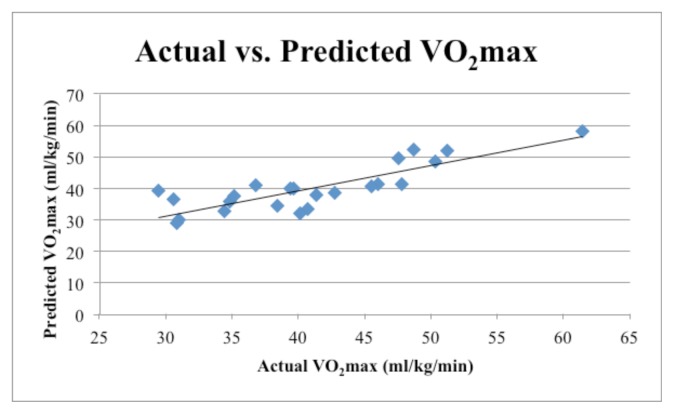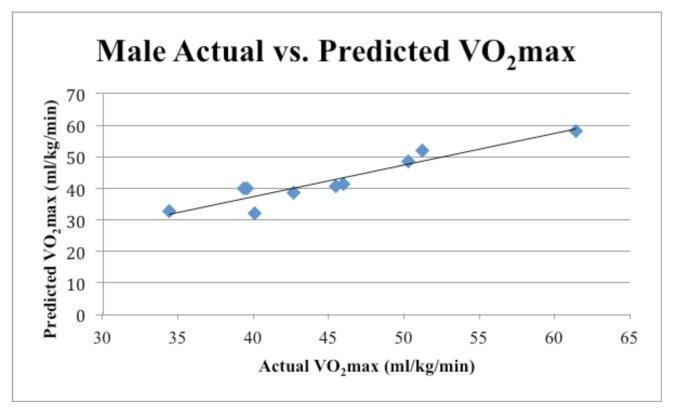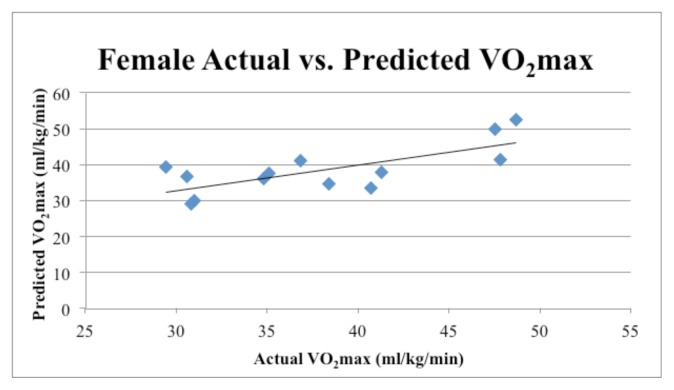Abstract
The Astrand-Rhyming cycle ergometer test (ARCET) is a commonly administered submaximal test for estimating aerobic capacity. Whereas typically utilized in clinical populations, the validity of the ARCET to predict VO2max in a non-clinical population, especially female, is less clear. Therefore, the purpose of this study was to determine the accuracy of the ARCET in a sample of healthy and physically active college students. Subjects (13 females, 10 males) performed a maximal cycle ergometer test to volitional exhaustion to determine VO2max. At least 48 hours later, subjects performed the ARCET protocol. Predicted VO2max was calculated following the ARCET format using the age corrected factor. There was no significant difference (p=.045) between actual (41.0±7.97 ml/kg/min) and predicted VO2max (40.3±7.58 ml/kg/min). When split for gender there was a significant difference between actual and predicted VO2 for males, (45.1±7.74 vs. 42.7±8.26 ml/kg/min, p=0.029) but no significant difference observed for females, (37.9±6.9 vs. 38.5±6.77 ml/kg/min, p=0.675). The correlation between actual and predicted VO2 was r=0.84, p<0.001 with an SEE= 4.3 ml/kg/min. When split for gender, the correlation for males was r=0.94, p<0.001, SEE=2.72 ml/kg/min; for females, r=0.74, p=0.004, SEE=4.67 ml/kg/min. The results of this study indicate that the ARCET accurately estimated VO2max in a healthy college population of both male and female subjects. Implications of this study suggest the ARCET can be used to assess aerobic capacity in both fitness and clinical settings where measurement via open-circuit spirometry is either unavailable or impractical.
Keywords: Exercise prescription, college students, maximal aerobic capacity
INTRODUCTION
The maximal amount of oxygen the body can take up during high intensity aerobic exercise is known as maximal oxygen capacity (1,8). Maximal oxygen capacity (VO2max) is commonly known as the gold standard measurement of aerobic fitness (1,8). Through high intensity exercise, respiration rate and blood flow become elevated, which results in a greater oxygen demand of the exercising muscles to determine the maximal oxygen capacity (1,8).
There are a variety of methods used to determine an individual’s VO2max through either the use of a direct maximal assessment or an indirect submaximal assessment. The type of test used, whether a submaximal or a maximal test, is specific to the population of interest. Clinicians and exercise specialists may utilize VO2max tests to determine the level of work one is able to withstand for a period of time, and to determine how the body is able to take up and utilize oxygen (1,5,8). For a clinical population, exercise physiologists often prefer to utilize submaximal aerobic capacity tests due to reduced cardiovascular demands on the aging or detrained populations when compared with a maximal test (1,8). On the other hand, exercise specialists and personal trainers who are working with a general fitness population, may select an actual maximal aerobic test, as this population is capable of performing work at a higher level. However, whereas tests of maximal aerobic capacity are indeed the gold standard for cardiorespiratory fitness assessments, such tests are time consuming, physically exhausting, and require expensive testing equipment (8). Further, the use of submaximal tests in non-clinical populations can be very useful in settings such as health fairs, initial fitness assessments in health clubs, and related instances where a potentially large group of subjects needs to be quickly and reliably assessed (1,8).
The Astrand-Rhyming cycle ergometer test (ARCET) is one of the most commonly administered submaximal tests to determine aerobic capacity (10). The original ARCET was determined from 58 subjects who performed submaximal tests on a cycle ergometer, which were compared to subsequent maximal tests on either a cycle ergometer or a treadmill (3). The data was then used to correlate heart rate at a submaximal state with a predicted maximal aerobic capacity (3). To determine the validity of similar submaximal aerobic tests, a number of studies have compared the difference between both submaximal and maximal aerobic tests, finding the ARCET was highly correlated (85%–95%) with tests to determine maximal aerobic capacity (10). Previous research has shown that the ARCET is reliable and deviates from treadmill tests by 6% (7). Additional research has also found that the ARCET shows a 15% standard deviation from directly measured maximal aerobic capacity (10). Whereas previous research has found the ARCET to be highly correlated in determining maximal aerobic capacity, the majority of previous studies investigating the ARCET have utilized only male subjects, thus few studies exist as to the validity of the ARCET in female populations. Therefore, the purpose of this study was to determine the validity of the ARCET as compared to a maximal aerobic capacity cycle ergometer test in a physically active and healthy college population of both males and females.
METHODS
Participants
A total of 23 physically active college students (13 females, 10 males, age 21.9 ± 0.7 years, height 171.4 ± 8.9 centimeters, weight 72.1 ± 13.7 kilograms) were recruited for this study. Inclusion criteria sought physically active participants in good health. This study was approved by the University’s International Review Board, and all subjects signed informed consent documents and a Physical Activity Readiness Questionnaire (PAR-Q) before participation. Participants with cardiorespiratory or other health problems that inhibited their ability to exercise were excluded from the study. All 23 subjects completed the study with no reported injuries. Physical characteristics of the subjects are presented in Table 1.
Table 1.
Physical characteristics of male and female subjects.
| Variable | Total (n=23) | Male (n=10) | Female (n=13) |
|---|---|---|---|
| Age (y) | 21.9 + 0.7 | 22.1 + 0.7 | 21.8 + 0.7 |
| Height (cm) | 171.4 + 8.9 | 178.7 + 6.8 | 165.7 + 5.8 |
| Body mass (kg) | 72.1 + 13.7 | 81.8 + 10.3 | 64.7 + 11.4 |
Values are given as a mean + SD.
Protocol
Prior to the tests, the subjects’ height and weight were recorded without shoes. In both tests, the participant wore an elastic band heart rate monitor (Polar Electro, Kempele Finland) with the use of electrode gel for better conduction. A cycle ergometer (Monark 874E, Stockholm, Sweden) was used for all testing. The cycle ergometer seat was set at the height of the subject’s hip and was kept constant through both the maximal test and the submaximal test. On the first day the subjects completed a maximal aerobic capacity test, and a minimum of 48 hours after the first test, performed the ARCET.
The subjects were instructed to refrain from eating or drinking two hours prior to the maximal test. Heart rate, Respiratory Exchange Ratio (RER), and maximal oxygen uptake (VO2max) were measured via indirect calorimetry with a metabolic cart (Parvo Medics True One 2400, Sandy, UT, USA). The metabolic cart was calibrated after every two subjects as per manufacturer’s instructions. The subject’s heart rate was monitored throughout the test. The subject was instructed to set the cycle ergometer seat height, keep their hands placed on the handlebars, and stay seated on the cycle ergometer throughout the duration of the test. A digital pedal cadence recorder on the cycle ergometer monitored the RPM’s. The subject performed a warm-up of three minutes with only the tray weight (1 kg) for resistance, pedaling at 70 RPM. At minute three the test started, and for every additional minute after the warm-up 0.3 kg was added to the previous weight on the tray. The test continued until the subject was exhausted or dropped below 65 RPM for 15 consecutive seconds. Verbal encouragement was also given throughout the test. After completion of the test subjects cooled down with only the tray weight (1 kg) as resistance until recovered. The subject’s data was recorded, which consisted of maximal heart rate, maximal oxygen uptake (ml/kg/min), and total duration of the test (min), recorded in 1-min averaging. The recorded data was saved for comparison with the submaximal test results. To determine if the subject felt that a maximal effort was expended, the Borg Rating of Perceived Exertion scale (RPE) was used, rated on a scale of 6–20.
Submaximal testing protocol was followed according to the ARCET protocol (1). Subjects set the seat height on the cycle ergometer to the same seat height used during the maximal test. Heart rate was monitored throughout the test. The subject warmed up at 50 RPM for three minutes with only the tray weight (1kg) for resistance. A digital pedal cadence recorder on the cycle ergometer monitored the RPMs. After the three-minute warm-up on the continuous time clock, the first power output was set and the six minute test began. For males the power output was set at 750 kilogram-force meter/minute (kgm) and for females the power output was set at 600 kgm. The heart rate was recorded during the last 30 seconds of minutes two through six of the test. At the end of minute three the power output was adjusted (either more or less), if the subject had not or will not reach the target heart rate zone of 120–170 bpm by the end of the six-minute test. The test ended at the end of minute six when the heart rate was within the target heart rate zone and less than 10 bpm different on two consecutive minutes (five and six) of the test. If these criteria were not met, the test was extended until the heart rate was within 10 bpm for two consecutive minutes. The last two heart rate values that were less than 10 bpm different were averaged and used for calculations. Upon test completion, the subject was allowed to cool down on the cycle ergometer until recovered. The predicted maximal aerobic capacity was calculated following the ARCET format using the age corrected factor (1).
Statistical Analysis
All data recorded was analyzed using IBM SPSS Statistics (version 20). Paired t-tests were used to analyze the differences between actual and predicted values of maximal aerobic capacity measurements. Pearson r correlation coefficients and Standard Error of Estimate (SEE) were calculated to determine the relationship between actual and predicted values of maximal aerobic capacity. The level of significance was set at p < 0.05.
RESULTS
Data from the actual and predicted maximal oxygen consumption (VO2max) tests are listed in in Table 2. Paired t-tests revealed there was no significant difference between actual (41.0 ± 7.97 ml/kg/min) and predicted VO2max (40.3 ± 7.58 ml/kg/min, t(22)=0.77, p=0.45). When split for gender there was a significant difference between actual and predicted VO2max for males, (45.1±7.74 vs. 42.7±8.26 ml/kg/min, p=0.029) but no significant difference observed for females, (37.9±6.9 vs. 38.5±6.77 ml/kg/min, p=0.675). The correlation between actual and predicted VO2max was r=0.842, p<0.001 with an SEE= 4.3 ml/kg/min (Figure 1). When split for gender, the correlation for males between actual and predicted VO2max was r=0.936, p<0.001 with an SEE 2.72 ml/kg/min (Figure 2). For females, the correlation between actual and predicted VO2max was r=0.735, p=0.004 with an SEE 4.67 ml/kg/min (Figure 3).
Table 2.
Actual and Predicted VO2 max values.
| Variable | Actual VO2max (ml/kg/min) | Predicted VO2max (ml/kg/min) | p-Value |
|---|---|---|---|
| Total | 41.0 ± 7.97 | 40.3 ± 7.58 | 0.450 |
| Male | 45.1 ± 7.74 | 42.7 ± 8.26 | 0.029* |
| Female | 37.9 ± 6.9 | 38.5 ± 6.77 | 0.675 |
Values are given as a mean ± SD.
indicates statistically significant difference.
Figure 1.
Relationship between actual and predicted VO2max for the overall group (n=23). (r=0.842, p<0.001, Standard Error of Estimate (SEE) = 4.3 ml/kg/min).
Figure 2.
Relationship between actual and predicted VO2max in male subjects (n=10). (r=0.936, p<0.001, SEE= 2.72 ml/kg/min).
Figure 3.
Relationship between actual and predicted VO2max in female subjects (n=13). (r= 0.735, p=0.004, SEE= 4.67 ml/kg/min).
DISCUSSION
The results of this study indicate that for the group as a whole, there were no significant differences between actual and predicted maximal aerobic capacity. When split for gender, the ARCET indicated no difference in female subjects, but for male subjects, underpredicted VO2max by 2.41 ± 3 ml/kg/min. However, this level of error is within previously established acceptable ranges for submaximal VO2max tests (1,8). Furthermore, the mean error on a group level was ~5% for men, and substantially less for women and the combined sample. Considering the ARCET is a field test, this level of error is relatively low when weighed against the resources and time needed to administer a maximal test (8). Additionally, previous research has determined the Standard Error of Measurement (SEM) for maximal cycle ergometer tests is 2.47 ml/kg/min (11); therefore the results from our study fall within this range, suggesting that the ARCET is an accurate predictor of VO2max within a healthy, collegiate population for both male and female subjects.
The results of our study are in accordance with previous studies investigating the ARCET and similar submaximal cycle ergometer protocols across a wide spectrum of populations, albeit primarily male. For example, Cink et al. (3) studied 40 highly trained male subjects, separated into well-trained, moderately trained, and untrained groups, and found no significant difference between actual and predicted maximal aerobic capacity (VO2max 54.6 vs. 52.9 ml/kg/min, r=.83, SEE=5.7). Moreover, Keren et al. (7) investigated 15 healthy, highly trained young adult males and found that the ARCET accurately predicted maximal aerobic capacity when compared with a maximal cycle ergometer test (VO2max 60.2 vs. 59.9 ml/kg/min, r=.85). Likewise, a study by Eston et al. (4) studied 13 sedentary adult males (38.4±7.4 years, VO2max 34.5 ± 7.4), concluding that predicted maximal aerobic capacity via cycle ergometer provides acceptable estimates of actual maximal aerobic capacity, showing no significant difference across trials (4).
As previously mentioned, the lack of research on female subjects with respect to the difference between actual and predicted VO2max from prior investigations of the ARCET and similar submaximal tests is a notable gap within the exercise science literature and implies a need for additional research. Therefore, our study provides valuable descriptive data as to the utility of the ARCET in a population of both healthy collegiate male and female subjects.
Limitations of our study include the recruitment of physically active young adults; therefore our findings should not be generalized to the population as a whole, particularly those who may be less physically active. Additionally, the use of the ARCET to predict VO2max is specific to cycling and thus should not be equated to a treadmill VO2max while writing an exercise prescription, as per principles of specificity of training adaptations (8).
In conclusion, the results of this study showed that the ARCET could be used as an accurate predictor of VO2max in a healthy college population. To collectively assess the accuracy and validity of the ARCET, future studies are advised to incorporate a larger sample consisting of a variety of populations may consist of different age groups and genders, as well as subjects ranging from sedentary to trained. Implications of this study suggest that within a population of healthy college students, it may not be necessary to perform a maximal test to exhaustion to accurately estimate maximal aerobic capacity. Exercise physiologists and fitness professionals may prescribe submaximal tests, such as the ARCET, which require less time, equipment, trained personnel to administer the test, and exertion of the individual to achieve accurate, valid, and reliable results (2).
REFERENCES
- 1.Astrand PO, Rodahl K, Dahl HA, Stromme SB. Textbook of Work Physiology. 4th ed. Champaign, IL: Human Kinetics; 2003. [Google Scholar]
- 2.Beekley M, Brechue W, DeHoyos D, Garzarella L, Weber-Zion G, Pollock M. Cross-validation of the YMCA submaximal cycle ergometer test to predict VO2max. Res Q Exerc Sport. 2004;75(3):337–342. doi: 10.1080/02701367.2004.10609165. [DOI] [PubMed] [Google Scholar]
- 3.Cink RE, Thomas TR. Validity of Astrand-Ryhming nomogram for predicting maximal oxygen intake. Brit J Sports Med. 1981;15:182–185. doi: 10.1136/bjsm.15.3.182. [DOI] [PMC free article] [PubMed] [Google Scholar]
- 4.Eston R, Lambrick D, Sheppard K, Parfitt G. Prediction of maximal oxygen uptake in sedentary males from a perceptually regulated, sub-maximal graded exercise test. J Sports Sci. 2008;26(2):131–139. doi: 10.1080/02640410701371364. [DOI] [PubMed] [Google Scholar]
- 5.Fitchett MA. Predictability of VO2max from submaximal cycle ergometer and bench stepping tests. Brit J Sports Med. 1985;19(2):85–88. doi: 10.1136/bjsm.19.2.85. [DOI] [PMC free article] [PubMed] [Google Scholar]
- 6.Gocentas A, Juozulynas A, Landõr A. Actual versus predicted maximal oxygen uptake in intermittent sport athletes. Papers Anthropol. 2009;10(18):104–112. [Google Scholar]
- 7.Keren G, Magazanik A, Epstein Y. A comparison of various methods for determination of VO2max. Eur J Appl Physiol Occup Physiol. 1980;45(2–3):117–124. doi: 10.1007/BF00421319. [DOI] [PubMed] [Google Scholar]
- 8.McArdle WD, Katch FI, Katch VL. Exercise Physiology: Nutrition, Energy, and Human Performance. 7th ed. Philadelphia, PA: Lippincott Williams & Wilkins; 2010. [Google Scholar]
- 9.Patton JF, Vogel JA, Mello RP. Evaluation of a maximal predictive cycle ergometer test of aerobic power. Eur J Appl Physiol. 1982;49:131–140. doi: 10.1007/BF00428971. [DOI] [PubMed] [Google Scholar]
- 10.Rexhepi AM, Brestovci B. Comparison of the 3’bike test with the Astrand bike test by VO2max. Hum Movement. 2011;12(4):348–352. [Google Scholar]
- 11.Vickers RR. Technical Report No. 04-03. San Diego, CA: Naval Health Research Center; Measurement error in maximal oxygen uptake tests. [Google Scholar]





